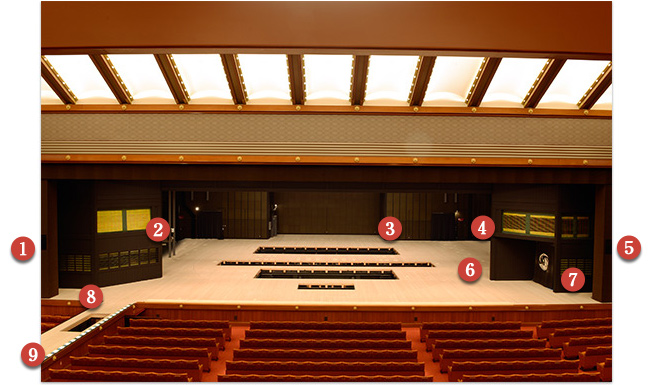Unique stage structures, Dynamic Stage Sets
The kabuki stage has a unique structure and that's what makes it all the more attractive! This is a picture of the Kabukiza theatre. Let's take a look at each part of the stage!

- Shimote
Stage left - Kuromisu
(See the page on 'Live music and sound effects' for more details.) - Seri
The holes in the stage are for stage lifts. They elevate or lower the actors and stage sets and create a dynamic atmosphere. - Yuka
Inside this space the narrative musicians sing or play the shamisen. Beneath this yuka sometimes you will see a raised dais that contains a spinning stage on which they also play in full view of the audience. - Kamite
Stage right - Mawari Butai
Revolving stage which turns 360 degrees. You might have seen a revolving stage in many other theaters, but this stage mechanism was actually first used in Kabuki! It turns around in scene changes. - Agemaku
The actors come in and out from this curtain. - Shichi-san
An important place on the hanamichi where the actors stop and pose. There is also a special stage lift here called the suppon. In Tokyo, use of this suppon is generally reserved for supernatural characters. - Hanamichi
A raised passageway running straight through the auditorium that brings the excitement and action of the dramas right into the audience's space. The passageway changes into various scenes: the ocean, the aisle of a castle, or a road, according to the performance. At the end of the hanamichi is another agemaku, a curtain through which the actors pass to and from the stage. The agemaku opens with a clattering sound and alerts the audience to when the actors will appear on the hanamichi.
With Kabuki's sophisticated stage machinery, including lifts and traps, many spectacular stage sets can be seen. Only Kabuki theatres in Japan are equipped with such amazing machinery as the suppon lift that allows actors to appear suddenly in the midst of the audience. Other stage lifts make it possible for whole buildings to rise up out of the ground, or for the huge roofs of dilapidated palaces to crash to the floor! The large revolving stage is said to have been invented in Japan in 1758, making it the oldest in the world! This revolving stage enables very rapid changes of set, as well as more dramatic scenes in which such things as boats can seem to move unaided from one place to the next. In certain scenes great roles of painted cloth can be cleverly manipulated to represent billowing waves or roaring fires... a beautiful spectacle... while in other sets you may see what looks like real barrels of oil spilled onto the stage, real rain or even a waterfall with actual water! Even if you've seen Kabuki on tour in other countries you won't have had the full experience until you visit a theatre in Japan.

Yataikuzushi ©Shochiku.

Gandogaeshi ©Shochiku.

